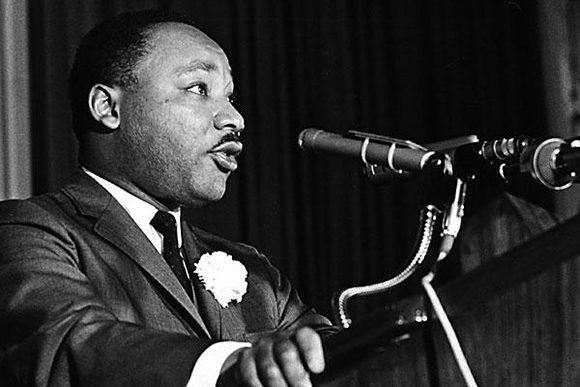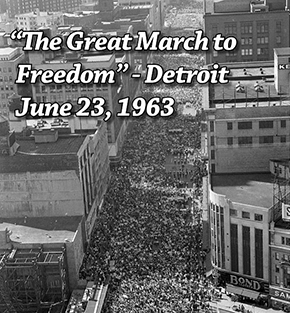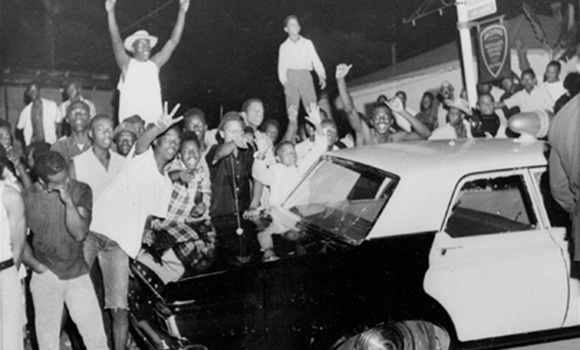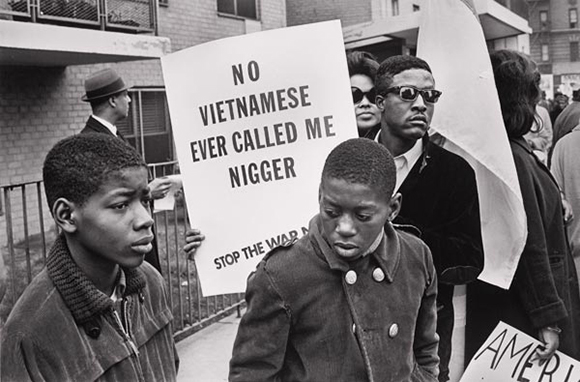by Malik Miah
January 20, 2014
On the occasion of the Martin Luther King holiday, we present this exploration of the unfinished economic and social justice agenda of the Civil Rights Movement. It was written as a review of a new book by Paul LeBlanc and Michael D. Yates, A Freedom Budget for All Americans, and appears in the January-February 2014 issue of Against the Current.

The Freedom Budget for All Americans was issued at a broadly endorsed conference in 1966. It was initiated by civil rights leaders A. Philip Randolph and Bayard Rustin, who co-founded the A. Philip Randolph Institute with funding from the AFL-CIO. The objective was to keep the momentum after the 1964 Civil Rights and 1965 Voting Rights Acts.
The Freedom Budget’s main goal was to end poverty for all American within 10 years, by 1975. Its primary authors were liberal economists and and supporters of the Socialist Party (SP) who were active in the “left wing” of the Democratic Party.
A. Philip Randolph, President of the Brotherhood of Sleeping Car Porters and the only African-American member of the Executive Council of the AFL-CIO, wrote the Introduction. He explained the Budget’s objective:
“The ‘Freedom Budget’ spells out a specific and factual course of action, step by step, to start in early 1967 toward the practical liquidation of poverty in the United States by 1975. The programs urged in the ‘Freedom Budget’ attack all of the major causes of poverty — unemployment and underemployment; substandard pay; inadequate social insurance and welfare payments to those who cannot or should not be employed; bad housing; deficiencies in health services, education, and training; and fiscal and monetary policies which tend to redistribute income regressively rather than progressively. The ‘Freedom Budget’ leaves no room for discrimination in any form, because its programs are addressed to all who need more opportunity and improved incomes and living standards — not just to some of them. …The ‘Freedom Budget,’ however, is not self-executing. It defines programs around which can be rallied all those individuals and groups who favor these programs and their objectives. But even with this convergence of forces, these individuals and groups will need to assume the political task of impressing upon their Government the obligation to undertake promptly the needed legislative and Executive programs. As is stressed throughout, improved operations under the Employment Act of 1946, commencing at once, must be the first focal point of the implementation process. The ‘Freedom Budget’ is thus an imperative call to national action — now.”
Martin Luther King, Jr., explained in the Foreword why he backed the Freedom Budget:
“It is not enough to project the freedom budget. We must dedicate ourselves to the legislative task to see that it is immediately and fully achieved. We must dedicate ourselves to the legislative task to see that it is immediately and fully achieved. I pledge myself to this task and will urge all others to do likewise. The Freedom Budget is essential if the Negro people are to make further progress. It is essential if we are to maintain social peace. It is a political necessity. It is a moral commitment to the fundamental principles on which this nation was founded. (October 26, 1966)
Eleven Goals
There were seven basic objectives summarized in 11 goals: abolition of poverty, guaranteed full employment, full production and high economic growth, adequate minimum wages, farm income parity, guaranteed incomes for all unable to work, a decent home for every American family, modern health services for all, full educational opportunity for all, updated social security and welfare programs, and equitable tax and money policies.”
The Budget was not specifically directed toward African Americans, who had suffered slavery and denial of political freedom. There was no mention of affirmative action (or reparations) for decades of violence and racism. The authors’ social-democratic and liberal vision assumed that a broad plan would benefit all Americans; it would uplift Blacks by default. There was also no analysis of white supremacist ideology prevalent in the Old South.
The 10-year plan would be paid for without new taxes, letting the corporations that benefitted from slavery and legal discrimination off the hook. It was based on an annual economic growth of five percent (an optimistic number). It was an appeal to “all Americans,” i.e. to convince whites that it was in their interests.
It also assumed that paying for the Vietnam War — which Rustin and Randolph tragically supported — and future wars were not in conflict with this goal.
The full document was 84 pages. A widely distributed 20-page summary was read by millions.
The Freedom Budget Concept
LeBlanc and Yates, longtime activists and socialists. discuss the content and origins of the Freedom Budget, the political thinking of civil rights leaders and the role of socialists. They also critique the labor officialdom that did not endorse the 1963 march.
“The Freedom Budget arose organically out of the activist wing of the civil rights movement: activists associated with Black trade union leader A. Philip Randolph and those involved in the Southern Leadership Conference (SCLC), Congress of Racial Equality (CORE), and the Student Nonviolent Coordinating Committee (SNCC).
“Often glossed over, however,” the authors add, “is that these men and women were influenced by conscious and organized forces that favored a socially owned and democratically controlled economy, one in which production would be for the benefit of all — in a word, socialism.” (21)
The Freedom Movement had a simple objective: full citizenship rights for African Americans. It was understood by all in the struggle that equal rights included economic justice as well as legal freedom. There were two central demands at the 1963 March on Washington, “Jobs and Freedom.” This was not an accident, since King and the other leaders said political freedom without economic equality is hollow.
Mass Action Strategy
What the authors call “The Strategy” of the Movement — built on using mass protests and nonviolent civil disobedience — was uncompromising. While Jim Crow segregation was the “low hanging fruit” that could be taken down, The Movement focused on political equality.

The battle to bring down legal discrimination was symbolized by two great marches in 1963: the “Great March on Detroit” in June, which had a large official labor backing, and the March on Washington.
The Detroit march is rarely mentioned since it occurred two months before the August Washington march. But King gave the first version of the “I have a Dream” speech there. The Detroit march emphasized the Jobs and Freedom theme, with the United Auto Workers playing a prominent role.
All civil rights leaders — whether activist (SCLC, SNCC, CORE) or legal-oriented (NAACP) — rejected a “gradualist” approach to ending inequality. The strategy of nonviolent civil disobedience was chosen as the most effective means to win enough whites to the struggle.
It hardly mattered which major party was in the White House. The Democratic Party had always compromised the interests of African Americans for the sake of its alliance with the openly racist southern Dixiecrats. The party of Lincoln likewise saw cheap Black labor as a source of big profits. It backed Black capitalism (small businesses in the Black community) from a philosophical point of view.
The death of Jim Crow legal segregation occurred with the Congress passing the Civil Rights Act in 1964 and the Voting Rights Act in 1965. The new laws signed by president Johnson, along with an Executive Order to take affirmative action in federal government employment, marked the end of the civil rights movement in the view of the ruling class.
The United States could now show the world that its stain of internal apartheid was over. Jim Crow, the authors note, was an embarrassment and undermined U.S. foreign interests in the former colonies of Africa and Asia that were now independent.
The dream of economic justice was now on the agenda.
Urban Rebellions
A weakness of the book is that the rising anger and militancy that led to sentiment for Black Power and support for Black Nationalist formations is barely mentioned.
A year after the Washington March, a major urban riot exploded in 1964 in Watts, Los Angeles. A year later, a rebellion occurred in Harlem, New York. And in 1967 after the Freedom Budget was released a big riot broke out in Detroit.

The Watts riot.
A growing fear struck a raw nerve of the ruling class. The “Old Guard” leaders who led the Civil Rights Revolution could not control or contain the new militancy.
As LeBlanc and Yates do explain, the leaders of the Movement were seasoned fighters for freedom. They understood anger and rebellion. Many came out of the trade union movement and the direct action wing of the civil rights struggle. Mass protests, from the Freedom Rides, to sit-ins and civil disobedience throughout the South, were well planned and led by genuine radicals — many from the radical pacifist and socialist traditions.
The Freedom Movement entered a more difficult political phase after 1965. No longer were the debates in the Black community over why and how to end legal segregation. Now it was over whether the battle for equality could be won by a slow and steady transformation of society, and by focusing on what the government should do.
Most of the leading foot soldiers and allies of King (especially after his murder) thought it was time to enjoy the fruits of the “victory.” They joined the Democratic Party, ran for office, got elected, started small businesses and received degrees in universities once off limit.
The new elite was born, living a life style long denied even to the most educated and wealthy African Americans. Working-class and poor Blacks, however, saw the task as more urgent: how to end segregation in the trade unions where skilled trades jobs excluded African Americans, in unions where Blacks held few top offices, and at big companies where many positions had been denied to qualified Blacks.
The push was to extend Johnson’s affirmative action for government jobs to the private sector. Expectations were high that a bigger victory was possible for the Black working class and poor. Political freedom without economic equality was not enough (we see a similar phenomenon in South Africa).
The sentiment was growing for revolutionary action. The views of Malcolm X resonated with the young generation. New formations like the Black Panther Party and League of Revolutionary Black Workers in Detroit arose. Organizations like SNCC, a leading force on college campuses during the sit-ins, moved to the left. The tensions in the late 1960s were deep.
Unfortunately the authors say very little about this nationalist division that led many of the radicalized and politicized youth like SNCC leader Kwame Toure (aka Stokely Carmichael, born in Trinidad but came to Harlem at the age of 11) to shift left and advocate revolution, not just reforms.
Socialist Influence
While the authors focus on the role of members of the Socialist Party, they do not discuss the role of the Communist Party or Socialist Workers Party (SWP) and other groups on the traditional socialist left. They do note that socialists were the most consistent forces within the organized freedom movement.
The socialist views of all currents influenced all the key African-American leaders of the activist wing. The SP was closer politically to those who did not connect the battle to end legal inequality to the longterm objective of revolution and building a socialist America. At best, SP leaders gave academic lip service to socialism.
Randolph, for example, was a member of the Socialist Party beginning in the 1920s. He organized the Sleeping Car Porters and led the fight to integration of the war industries and the AFL and CIO unions. In a Black-led union many of his best organizers and supporters came from the Communist and Socialist groups. His protégé Bayard Rustin was a member of the Young Communist League in the 1930s before he quit over Soviet foreign policy.

Bayard Rustin.
Randolph and Rustin (who was outed as gay in the 1950s) were the main organizers of the March on Washington, and helped bring in union support. After the civil rights laws were passed, the AFL-CIO established the A. Philip Randolph Institute in 1965 even though George Meany, its president, refused to endorse the 1963 March. Only the UAW’s Walter Reuther and Randolph on the AFL-CIO Executive Council supported the March.
The key voice in a shift from “protest to politics” after 1965 was Randolph. He called for the shift in this famous essay, as the authors note. The socialists of the Socialist Party led by six-time presidential candidate Norman Thomas, Michael Harrington (author of the highly praised book The Other America: Poverty in the United States, discussed elsewhere in this issue) and its “orthodox” Marxist wing led by Max Shachtman agreed.
Shachtman’s own evolution from revolutionary Marxist to Cold War socialist led him to support the U.S. war in Vietnam. The socialism of the SP leaders in any case was not revolutionary. From Norman Thomas to Max Shachtman to Michael Harrington, they rejected building an independent labor party, much less a revolutionary socialist party.
Shachtman, as the authors explain, led the faction in the SP arguing that socialists should be active in the “left liberal wing” of the Democratic Party where the workers (represented by the union officials) resided. He also advocated a “realignment” strategy. The aim was to push the Dixiecrats out of the Democratic Party and transform the Party into a broad coalition of the labor bureaucracy, civil rights leaders and liberals.
Ironically, that realignment did occur when the Republican Party assimilated the racist anti-Black Dixiecrats in the 1970s, a success credited to Nixon and Reagan.
Why Freedom Budget Failed
The Freedom Budget failed, “defeated” in the authors’ words. Why? In principle, it was a radical plan to change the country. Its leaders for the most part — with the important exception of Martin Luther King — wanted to shift the Freedom Movement to mainstream tactics and away from mass street protests.
The leaders misread the changes won, and the commitment of the ruling class to see them through. Instead a pushback by the rulers began to limit the gains won by African Americans. The SP leaders were also wrong on Vietnam, the military-industrial complex and the belief that guns and butter are compatible.
In 1965, Johnson sharply escalated U.S. military intervention in Vietnam, which John Kennedy had initiated from the early 1960s. The leaders of the Socialist Party who helped draft the Freedom Budget supported the U.S. war against the National Liberation Front of Vietnam. The SP considered “communism” and any group backed by the Soviet Union or Mao’s China as a system worse than capitalism.
The AFL-CIO supported U.S. foreign policy and aided the CIA in its operations in Europe, Asia and Latin America. Civil rights leaders were divided over the “guns versus butter” debate and its effect on civil rights. Most tried to avoid issues like Vietnam, which was not seen as a civil rights issue.
As a pacifist, Rustin was personally opposed to intervention as the authors note. But his support of the SP position led him and Randolph to give critical support to the U.S. war and oppose those including former comrades who were active in the antiwar movement.
King, in 1967, was the first leader to come out against the Vietnam War. Muhammad Ali popularized it best when he refused to be drafted, sentenced to five years in prison and was stripped of his world boxing championship: “No Viet Cong ever called me Nigger!”

Another factor little discussed in the book is the rise of militant Black Nationalism represented by Malcolm X, who was assassinated in 1965. There was a shift by many Black youth to Black Power and revolutionary Back Nationalism and Pan Africanism. These youth saw clearly that real equality could not be won under capitalism.
The leaders of the left wing of the African-American community were attacked by the “old guard” and reactionary leadership of the AFL-CIO. In a 1966 “Letter to Black Youth,” Bayard Rustin criticized advocates of Black Power and self-determination.
An ad was published in The New York Times (October 14, 1966) attacking the militant nationalists and denouncing Black Power. It reiterated the goal of integration, not separatism. Interestingly, King did not sign the ad as he was still listening to all voices in the community. King never shifted from advancing an activist agenda on poverty, housing and jobs as others turned to electoral politics.
Other Tendencies
In the late 1960s and 1970s, many young Black militants had gone beyond the belief that the system could be reformed to bring full citizenship and income equality. Defending the right of Blacks to self-determination and internationalism was a key argument against the “integrationist” strategy in the post-Jim Crow era.
Some on the far left of the Black movement in the 1970s believed that the only way to fully implement the goals of the Civil Rights Movement was by revolution.
The Freedom Budget in their view was self-limiting and lacking a worldview on the ongoing battles in Africa against apartheid in South Africa and the fights in the Portuguese colonies in Angola, Mozambique, Guinea-Bissau and East Timor. It was a sectarian position, unfortunately, that led many of them to ignore the potential dynamics of the Freedom Budget demands.
It’s too bad that the authors did not discuss the role and impact of other socialist tendencies on the Freedom Movement.
The Communist Party, for example, endorsed the 1966 Freedom budget. Its longtime activist stance against discrimination was why many civil rights activists joined or supported the CP.
The main Trotskyist current, the Socialist Workers Party (SWP) supported the Freedom Now Party in Michigan and the idea of an independent Black Political Party. Many Black trade union militants read Trotsky because of his writings on why Blacks would play a vanguard role in the revolutionary movement in the United States.
Unlike the SP, the SWP supported Black self-determination, which the SP did not. It viewed the democratic proposals of the Freedom Budget as “transitional demands” that could mobilize the Black community and challenge the power of the state.
In the end, for many reasons including the terror from the FBI and police agencies, most of the activist wing of the movement followed Randolph’s view that it was time to join the mainstream (capitalist) politics and leave the streets. Most joined the Democratic Party to run for public office or have become part of the new African American middle class.
A Valuable Contribution
LeBlanc and Yates aren’t just looking back at the Freedom Budget as a significant historical development. Their purpose is to propose a revival of the Freedom Budget itself, in what they call a “New Freedom Budget for All Americans.” However it cannot be separated from the fight to end imperialist wars. The authors correct this historic omission in their updated principle 5, “Harmony with global neighbors.” (274)
The era of U.S. drones and invasions has settled the question of whether full economic equality is possible without taking on that war machine and military-industrial complex.
The core principles of a New Freedom Budget advanced by the authors are worth fighting for. The question is whether a broader coalition of labor, civil rights groups, immigrant rights organizations and women’s rights groups and others will take it up — and make it happen as an independent movement outside the Democratic Party, and reject the capitalist market framework.
The central lesson of history is that fundamental change occurs only by mass collective action. People’s action must continue or those gains will be eroded and reversed.
The new book is a valuable contribution, because it teaches today’s generation how mass civil disobedience won a historic victory — and just as important, how the need for political independence is key to preserving and moving beyond those gains to a socialist conclusion.
